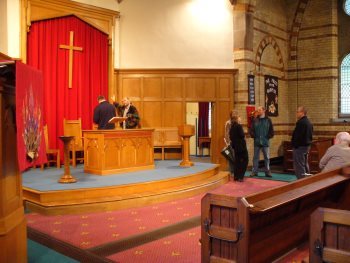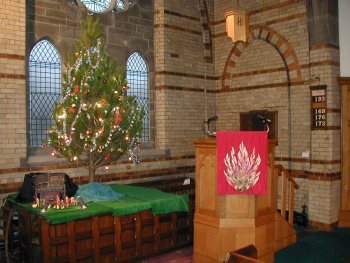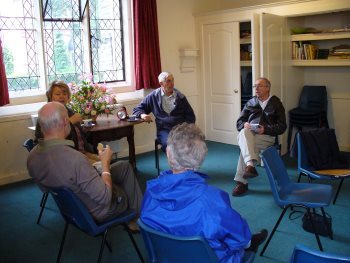|

|
Trinity. the Church on 'The Downs'.
Historically, the story of
the Downs is simple and uneventful. Over 100 years ago, its slopes were
covered with fertile pastures and richly cultivated gardens, with here
and there a farmstead and a few isolated cottages with white washed
walls and thatched roofs. The roads were narrow and winding, bounded
by thick hedgerows and overhung with leafy boughs. The principal path
by which the villager climbed the hill to Bowdon was by a road from
the present Railway street; which wound by way of Higher Downs and the
Firs to the grey and historic Bowdon Church.
In the Civil war of 1644, Bowdon Downs was disturbed
by no incident more important than that it was the halting place of
the army, commanded by Prince Rupert, in the operations for the relief
of Chester which was, at that time, besieged by Sir William Brereton,
a prominent parliamentarian leader. It was told by William Davenport,
a Royalist Chronicler of Bramhall, that Prince Rupert marched up to
Cheadle, where the Parliamentarian forces ran away.
|
|
And so it was, that in
the same modest Chapel in which the previous churches had been established,
that the Bowdon Presbyterian church held its first service on the 22nd
December 1867 The first Session, which was appointed on 7th January
1868 consisted of a minister and elders from the Manchester Presbytery.
On 19th November 1868 the Rev W.T. Johnston, afterwards Dr Johnston,
was called to take charge. He accepted the call and was ordained the
following January. Mr Johnston was a native of Greenock, was educated
at Glasgow University and had officiated for a year in Free St John's,
Edinburgh, and for a year in Woolwich. On his appointment to Bowdon,
the membership of the congregation on the roll was 35, and there was
a small Sunday school.
Mr Johnston who resigned in December 1885 to undertake
ministerial duties in Worcester had seen in his pastorate the congregation
greatly increase and so in 1870 it was decided to build a new church.
The site selected was in Delamer Road, where a handsome church was erected
in the Gothic style of architecture. The appearance of the building
was enhanced by a spire of 120 feet in height. Adjoining the main building
was a fine lecture hall. The church cost in excess of £6,000,
and was opened on September 22nd 1872. The spire, however, has since
caused problems. In 1935 it was necessary to demolish and rebuild the
spire at a cost of £73, by 1970, however, the upper part had become
dangerous again, and in March 1971 the upper section was removed, this
time at a cost of £975.
|

Drawn by Basil Morrison.
|
|
Special reference must be made to the founding
of the Trinity Mission, perhaps the earliest and certainly the most
successful of the congregation's attempts at Christian outreach. In
1883 the Manchester City Mission, which had formed a Mission in a small
room in Victoria Street, Altrincham, some time previously, decided not
to re-appoint a full time missioner. Thereupon, the work was taken over
by a number of volunteers from Trinity. Under the new leadership, the
mission outgrew the house in which it was formed after eight years and
in 1891 a new Mission Hall in Stamford Street was opened. The bulk of
the funds for the building of the new mission were raised by a mammoth
three days sale of work. The new building was in a strategic position,
for at the time the whole of that area, including the site of the present
Station House, was densely populated. For many years the mission stood
at the heart of a busy and populous "parish" and up to the
last war had a most active life of its own. The mission finally closed
and its building was demolished in 1967, but many remember its great
contribution to the spiritual and social life of Altrincham, and we
can honour the vision and the efforts of those who responded to its
challenge. The fact of the mission added a new and important dimension
to the life of our congregation and opened a window upon the needs of
the community beyond Trinity's four walls.
Towards the end of the 19th century, people made their own
entertainments, and every church was a centre of social activity. At
Trinity, Bowdon, the Dorcas Society was in full swing and a literary
society, 82 members strong, was holding Shakespearian Readings and listening
to lectures on the ethics of Tolstoy; while at the mission, there was
a flourishing Girls club, a Mothers Meeting and a series of the ever
popular Lantern Lectures. The new church on Delamer Road was gradually
beginning to assert itself in the community. In 1900 the first United
August services were held with the Downs Congregational Church and continued
until the amalgamation of the two churches in 1974.
The Rev. W.T. Johnston was succeeded by the Rev. Robert Cunningham,
who was inducted on 10th March 1887. Mr Cunningham's brief pastorate
ended with his sudden death whilst attending a meeting of the Manchester
Presbytery on 10th September 1888. The Rev. Wilson Cowie, who accepted
the call of the church, was inducted in September 1889. He held the
pastorate until his death, after a short illness, on 27th February 1901.
His ashes, and those of his wife, are buried beneath Trinity, close
to the chancel. Mr Cowie was succeeded by the Rev. R.M. Gray on 6th
October 1901. Mr Gray was followed in May 1913 by the Rev. R.J. Wright
who left in September 1918 to take charge of the Somerset Road church
in Bolton and on 26th March 1919, the Rev. Lewis G Tucker was inducted
as minister. At the end of May 1934, Mr Tucker resigned to take up the
pastorate of St Andrews Church, Cheltenham, and he was succeeded on
the 13th February 1935 by the Rev. G Armstrong Bannister whose services
continued during the years of the Second World War until January 1945.
The outbreak of war took away many of Trinity's men and imposed many
new restrictions, but the work went on, often under great dificulties.
During the ministry of Revd R Hutchinson, recovery after the war was
a slow business, but gradually the membership began to increase and
the children's church to revive, probably due to the fact that there
was more movement of young families coming into the area, and it was
at Trinity that they found a really warm and sincere welcome.
The more recent history of the congregation is fairly fresh in our minds,
but it was felt for some time that the interior of the church needed
some attention, so in 1963 the central pulpit was removed and a new
pulpit was placed in the Transept, and the chancel area was newly carpeted,
a new communion table and Elders chairs were donated, and the adjacent
walls were panelled. Behind the communion table was hung a curtain on
which was fixed a plain wooden cross. These new furnishings were dedicated
in January 1964 by Emeritus Principal R D Whitehorn of Cambridge.
In the field of leadership at Trinity, there are numerous records of
long and faithful service. We have been richly blessed by a long and
faithful ministry exercised by the Revd David Howell-J ones, who was
called to Trinity as a young man in 1959 and remained for almost 30
years. In recent years there has been an excellent supply of members
well fitted for the duties of elder and manager, and it is strange to
recall that more than a century ago, there was difficulty in persuading
any of the members to accept election for the Eldership. We should not,
however, forget the countless ways in which many members of the congregation
continue to take part in services to the community or their work in
connection with the wider church.
After the departure of Revd Howell-J ones, there followed Trinity's
longest interregnum, during which time services were led by members
of the church and by many visiting laymen and clergy including some
from other denominations, a demonstration of the ecumenical fellowship
that exists in the district.
Trinity welcomed its present minister, Revd David Westhead on 20th September
1991, and we look forward to a long and happy association with him and
his family.
Long may Trinity continue to minister here in Bowdon.
Melvin Roberts.
|
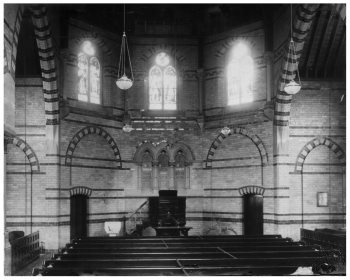
The original chancel.
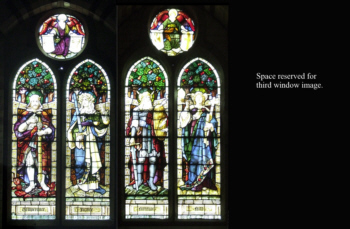
The Macdonald Windows
The stained glass windows
high above the Chancel were donated by me Macdonald family in memory
of Mr Charles Macdonald, who was a Session Clerk at Trinity from 1883
until I909.
The windows were designed and made by Percy
Bacon and portray three pairs of men and women representing three
supernatural, theological, or Christian virtues, Faith , Hope Chanty,
and Three of Plato's cardinal or natural virtues, Temperance, Justice,
and Fortitude. Prudence, the seventh virtue is not shown, the artist
may have chosen an appropriate 'Trinity' design.
The Artist and Designer, Percy Bacon was a
frequent exhibitor at the Royal Academy during the latter part of
the l9th Century and the early part of the 20th Century, his work
both in glass and and wood was commissioned for a number of churches
both in Great Britain and abroad .
He was strongly influenced by the work of
Edward Burne-Jones.
Window 1. Temperance
A man clad in the whole armour of righteousness,
stands upon fire and serpents representing temptations, holding a
sword in its scabbard, tightly bound to the hilt with cord, signifying
self control.
Window 2. Justice
A Woman holding an unsheathed sword and scales.
Window 3. Fortitude
A warrior with a dart resisting shield. On
which there is a lion rampant, signifying bravery. He has the breastplate
of righteousness and the sword of the spirit. His feet are planted
upon a rock.
Window 4. Faith
A female figure with a winged head, symbolising
swiftness of thought 0n the nimbus, or halo is a sun, for fervour,
a new moon for purity, and stars for guidance. The torch in her right
hand symbolises spiritual light. The light behind her shines very
brightly on a sunny day. The Cross is the emblem of salvation, the
book in her other hand is the Bible.
Window 5. Hope
A male figure dressed as a Pilgrim on Life's
rough way, holds a small flask and a cockle_shell, suggesting scanty
provision of the worlds goods.
His use of a rough staff shows that the path is difficult, but that_he
is pressing on. His eyes look upward to the object of his journey.
His emblem held by an Angel in the tracery right above is the dove
with the olive branch looking for a restring place.
Window 6. Charity
The figure of a mother tramps upon a bag of
gold which is as nothing when compared with love. Roses spring up
in her path, the baby is helpless but for her. The faming heart on
the shield above is the emblem of love.
|







